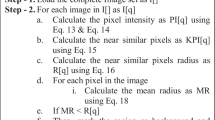Zusammenfassung
Accurate segmentation of breast lesions is a crucial step in evaluating the characteristics of tumors. However, this is a challenging task, since breast lesions have sophisticated shape, topological structure, and variation in the intensity distribution. In this paper, we evaluated the performance of three unsupervised algorithms for the task of breast Magnetic Resonance (MRI) lesion segmentation, namely, Gaussian Mixture Model clustering, K-means clustering and a markercontrolled Watershed transformation based method. All methods were applied on breast MRI slices following selection of regions of interest (ROIs) by an expert radiologist and evaluated on 106 subjects’ images, which include 59 malignant and 47 benign lesions. Segmentation accuracy was evaluated by comparing our results with ground truth masks, using the Dice similarity coefficient (DSC), Jaccard index (JI), Hausdorff distance and precision-recall metrics. The results indicate that the marker-controlled Watershed transformation outperformed all other algorithms investigated.
Access this chapter
Tax calculation will be finalised at checkout
Purchases are for personal use only
Preview
Unable to display preview. Download preview PDF.
Similar content being viewed by others
Literatur
Xi X, Shi H, Han L, et al. Breast tumor segmentation with prior knowledge learning. Neurocomputing. 2017;237(Supplement C):145 – 157.
Jayender J, Chikarmane S, Jolesz FA, et al. Automatic segmentation of invasive breast carcinomas from dynamic contrast-enhanced MRI using time series analysis. J Mag Res Imaging. 2014;40(2):467–475.
Thomassin-Naggara I, Trop I, Lalonde L, et al. Tips and techniques in breast MRI. Diagnost Intervent Imaging. 2012;93(11):828 – 839.
Zhang H, Fritts JE, Goldman SA. Image segmentation evaluation: a survey of unsupervised methods. Comput Vis Image Understg. 2008;110(2):260 – 280.
Amrehn M, Glasbrenner J, Steidl S, et al. Comparative evaluation of interactive segmentation approaches. In: Bildverarbeitung für die Medizin 2016. Berlin Heidelberg; 2016. p. 68–73.
Moftah HM, Azar AT, Al-Shammari ET, et al. Adaptive k-means clustering algorithm for MR breast image segmentation. Neural Comput Appl. 2014 Jun;24(7-8):1917–1928.
Soffientini CD, De Bernardi E, Zito F, et al. Background based gaussian mixture model lesion segmentation in PET. Med Phys. 2016;43(5):2662–2675.
Vesal S, Diaz-Pinto A, RaviKumar N, et al. Semi-automatic algorithm for breast MRI lesion segmentation using marker-controlled watershed transformation. In: IEEE Nuclear Science Symposium and Medical Imaging Conference Record; 2017. In press.
Diaz A, Morales S, Naranjo V, et al. Glaucoma diagnosis by means of optic cup feature analysis in color fundus images. Proc EUSIPCO. 2016 Aug; p. 2055–2059.
Reza AM. Realization of the contrast limited adaptive histogram equalization (CLAHE) for real-time image enhancement. J VLSI Sign Process Syst Sign Image Vid Tech. 2004 Aug;38(1):35–44.
Xu S, Liu H, Song E. Marker-controlled watershed for lesion segmentation in mammograms. J Digit Imaging. 2011 Oct;24(5):754–763.
Author information
Authors and Affiliations
Corresponding author
Editor information
Editors and Affiliations
Rights and permissions
Copyright information
© 2018 Springer-Verlag GmbH Deutschland
About this paper
Cite this paper
Vesal, S., Ravikumar, N., Ellman, S., Maier, A. (2018). Comparative Analysis of Unsupervised Algorithms for Breast MRI Lesion Segmentation. In: Maier, A., Deserno, T., Handels, H., Maier-Hein, K., Palm, C., Tolxdorff, T. (eds) Bildverarbeitung für die Medizin 2018. Informatik aktuell. Springer Vieweg, Berlin, Heidelberg. https://doi.org/10.1007/978-3-662-56537-7_68
Download citation
DOI: https://doi.org/10.1007/978-3-662-56537-7_68
Published:
Publisher Name: Springer Vieweg, Berlin, Heidelberg
Print ISBN: 978-3-662-56536-0
Online ISBN: 978-3-662-56537-7
eBook Packages: Computer Science and Engineering (German Language)




